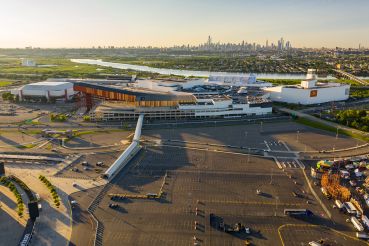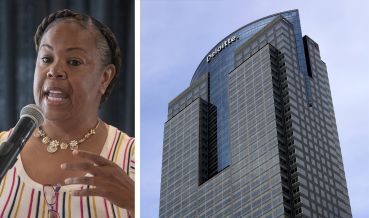Multifamily Hits Speed Bumps After Rapid Growth
Once a no-brainer for commercial real estate investors, the asset class faces fresh scrutiny amid sluggish rent growth
By Andrew Coen February 8, 2023 8:30 am
reprints
The red-hot multifamily sector that appeared impenetrable to macroeconomics for much of the COVID-19 pandemic is beginning to show some signs of cooling.
Still, despite declines in multifamily rents of late, the asset class remains an attractive commercial real estate investment depending on the market and financing terms, according to analysts.
Average U.S. asking monthly rents for December 2022 fell $4 to $1,775 during the month and were down by $10 in the fourth quarter, with 25 of the top top 30 metro areas showing negative growth, according to data from Yardi Matrix. National asking rent growth was also down 6.2 percent compared to late 2021 and slipped 80 basis points from November, the Yardi Matrix data showed.
While the multifamily market overall saw record-low vacancy rates in 2022, some developers are facing pressures to stay afloat. That includes the Chetrit Group, which was in danger of defaulting on a 2019 $481 million commercial mortgage-backed securities (CMBS) loan tied to 43 rental properties, according to a year-end Trepp report. The company failed to pay off the loan when it was due last year as it got saddled with below-average occupancy levels and rising interest rates on its floating-rate debt.
JPMorgan Chase supplied the loan for Chetrit’s acquisition of a 8,671-unit portfolio spread across New York, the Sun Belt, Ohio, Indiana and Illinois. The loan entered special servicing after it was transferred for maturity default on July 9, 2022, according to Marc McDevitt, senior managing director at CRED iQ. McDevitt noted that as of January, four Ohio properties were released to help pay down the debt.
“CMBS investors are typically concerned with adverse selection in situations that require drawn-out portfolio releases of distressed properties, which could leave behind some of the lower-quality properties when it’s time to endgame the remaining debt,” McDevitt said.
McDevitt noted that the remaining 39 properties in the Chetrit portfolio have occupancies ranging from below 70 percent to above 90 percent on the high end, with all but six experiencing declines since loan origination.
Even though the Sun Belt’s population has grown robustly the last few years, properties in Tennessee and Louisiana, as well as Ohio, were among the worst performing in the Chetrit portfolio, according to McDevitt. He stressed that some of the assets marketed for sale could attract interest from investors with dry power pursuing value-add or core-plus strategies.
“Working in investors’ favor are release prices ranging from 115 percent to 120 percent of a property’s allocated loan amount and loan-to-value thresholds,” McDevitt said. “The borrower will likely walk a fine line choosing which properties to sell in order to pay down the mortgage, and the special servicer is expected to be prudent in securing the best outcome for certificate holders.”
Representatives at the Chetrit Group did not return a request for comment.
While multifamily rents increased nationally by 6.2 percent in 2022 — marking the second-highest annual growth in the 21st century behind only 2021’s nearly 15 percent jump — the rental market is shaping up for only modest growth in 2023 after remaining relatively flat early in the year, according to Paul Fiorilla, director of U.S. research at Yardi Matrix. The only two major markets to record rent growth in the fourth quarter were Indianapolis and New York City, with 0.4 and 0.3 percent growth, respectively.
Even with slightly less growth this year, the multifamily market is well positioned overall given the last two years of strong growth, Fiorilla said. Rising interest rates will challenge multifamily owners, but he noted that properties are not as overleveraged as they were during the 2007-2008 Global Financial Crisis, and he said sponsors who took out loans more than three years ago will have some cushion from rent growth.
The delinquency rate for multifamily properties is likely to rise in 2023, but it remains around 2 percent, far lower than other sectors such as office, according to Fiorilla.
“Any increase in delinquencies is not a good thing, but I think we have to put it in perspective given how we are coming off such incredibly low levels,” Fiorilla said. “We’re looking at some scattered problems related to individual properties that are not well capitalized, but I don’t see a hard landing or crash or bubble.”
The delinquency rate for multifamily properties is likely to rise in 2023, but it remains far lower than other sectors such as office, according to Fiorilla. Multifamily delinquencies are roughly two percent for CMBS and much lower for government-sponsored entities and portfolio lenders.
The multifamily loans that will face the most risk of default, according to Fiorilla, are ones issued in the last three years with a floating-rate structure, made at very low interest rates, which have not benefited as much from rising rent growth as similar transactions that went to market around a decade ago. However, if interest rates decrease in the next couple of years once inflation stabilizes, owners of these struggling properties will be better positioned to refinance loans. This will gain them necessary capital to improve cash flows and building enhancements.
Tony Fineman, senior managing director and co-head of national originations for Acore Capital, said multifamily still has some positive fundamentals such as a lack of supply and higher mortgage rates that result in more would-be homeowners seeking rentals instead. However, he noted that Acore is proceeding more “cautiously” with multifamily deals at the moment given how rising interest rates are affecting valuations.
“There were a lot of very low cap rate acquisitions and valuations that we believe will be impacted by the interest rate environment that we’re going to be in for the next at least many months to a couple of years,” Fineman said. “There’s going to be some pressure on a bunch of acquisitions and trades over the last many years, which doesn’t necessarily affect the demand for the product, but it does affect how the capital markets treat them.”
Fineman stressed that Acore continues to invest in multifamily projects but is lending at a lower basis than two years ago because of the effect on values from higher cap rates amid rising interest rates and the need for more cash flow. He said some properties with loans from around a decade ago will benefit from increased rent growth to offset the pressure on valuations.
Despite some headwinds facing multifamily, the asset class remains very attractive to foreign investors, according to Mitchell Hunter, global chief commercial officer at Trimont Real Estate Advisors.
Hunter said investors he works with around the world are focused very heavily in the growing Sun Belt and are prioritizing assets with strong environmental, social and corporate governance (ESG) characteristics such as upgraded sustainability features.
“We have seen a huge exit of renters in the gateway cities, so I expect to see investors follow renters to the growing areas located mostly in the Sun Belt region,” he said. “Cities like Dallas, Houston and Atlanta have seen an influx of renters over the past couple of years.”
Hunter said that physical occupancy numbers for U.S. multifamily will look bad for much of 2023 as eviction protections implemented during the COVID-19 pandemic work their way through the legal system for nonpaying tenants. Still, he sees overall numbers improving “considerably” as more units become available for rent.
Demand for multifamily remains very high in markets like New York where the rate of production is way behind targets necessary to make a material dent in the city’s housing crisis. The Real Estate Board of New York’s latest report on multifamily construction, released Feb. 1, showed developers filed foundation permit applications for 22 new projects citywide in December 2022 for a total of 590 residential units, a 90 percent annual decline.
Sentinel Real Estate has been investing in multifamily since 1969. Nick Stein, its managing director, noted that while some markets that experienced significant rent growth during the pandemic’s first two years, like Phoenix and Tampa, are experiencing more of a dip as conditions normalize, operational performance continues to remain healthy. Investors just have to take the long view.
“What we’ve seen so far is those markets have adjusted back to a more normalized environment a little bit more quickly, but they had a longer way to adjust because they had been so strong,” said Stein of multifamily in the Sun Belt. “It’s not necessarily that those markets are performing badly or even badly relative to other markets. It’s just that they were so strong relative to other markets before, and that outperformance is not there.”
Andrew Coen can be reached at acoen@commercialobserver.com.


